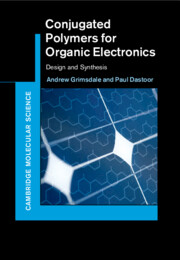Book contents
- Conjugated Polymers for Organic Electronics
- Cambridge Molecular Science
- Conjugated Polymers for Organic Electronics
- Copyright page
- Contents
- Preface
- Abbreviations
- 1 Introduction
- 2 Polyacetylenes
- 3 Poly(arylene vinylene)s
- 4 Poly(arylene ethynylene)s
- 5 Poly(phenylene)s
- 6 Polyfluorenes and Related Polymers
- 7 Polythiophenes
- 8 Other Arylene-Based Polymers
- 9 Hyperbranched Polymers, Star Polymers and Dendrimers
- 10 Polymers with Molecular-like Chromophores
- 11 Polymers for Phosphorescent LEDs
- 12 Polymers for White-Emitting PLEDs
- 13 Polymers for Other Luminescent Devices
- 14 Conclusion and Outlook
- References
- Index
6 - Polyfluorenes and Related Polymers
Published online by Cambridge University Press: 28 March 2024
- Conjugated Polymers for Organic Electronics
- Cambridge Molecular Science
- Conjugated Polymers for Organic Electronics
- Copyright page
- Contents
- Preface
- Abbreviations
- 1 Introduction
- 2 Polyacetylenes
- 3 Poly(arylene vinylene)s
- 4 Poly(arylene ethynylene)s
- 5 Poly(phenylene)s
- 6 Polyfluorenes and Related Polymers
- 7 Polythiophenes
- 8 Other Arylene-Based Polymers
- 9 Hyperbranched Polymers, Star Polymers and Dendrimers
- 10 Polymers with Molecular-like Chromophores
- 11 Polymers for Phosphorescent LEDs
- 12 Polymers for White-Emitting PLEDs
- 13 Polymers for Other Luminescent Devices
- 14 Conclusion and Outlook
- References
- Index
Summary
Intermediate between PPPs and LPPPs in structure are stepladder polymers in which the monomers contain two or more phenylene units which are connected by one or two atom bridges. The simplest and most widely studied of these are poly(dialkylfluorene)s (PDAFs) whose monomers are biphenyl units linked by one carbon bridges. These were developed as blue-emitting materials, but their emission is unstable due to formation of emissive ketone defects by oxidation of monoalkylfluorene impurities. This problem can be overcome by replacing the alkyl groups with aryl groups or by making the monomers by routes which give only fully dialkylated compounds. The efficiency of the devices can be improved by incorporation of charge-transporting groups, while the emission colour is tunable by incorporation of emissive dye units. The emission from PDAFs is a violet-blue, but pure blue emission has been obtained by making polymers from monomers containing a larger number of linked phenylene rings. Also discussed are the synthesis and properties of other step-ladder polymers such as polycarbazoles which are analogous to PDAFs but contain nitrogen instead of carbon bridges.
- Type
- Chapter
- Information
- Conjugated Polymers for Organic ElectronicsDesign and Synthesis, pp. 74 - 103Publisher: Cambridge University PressPrint publication year: 2024



